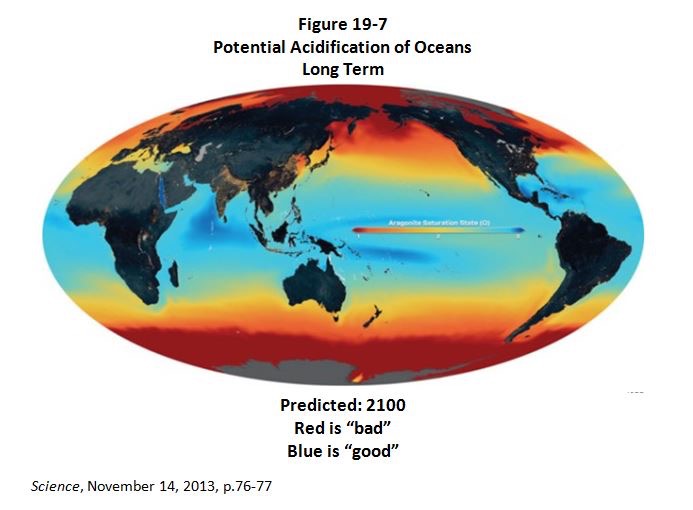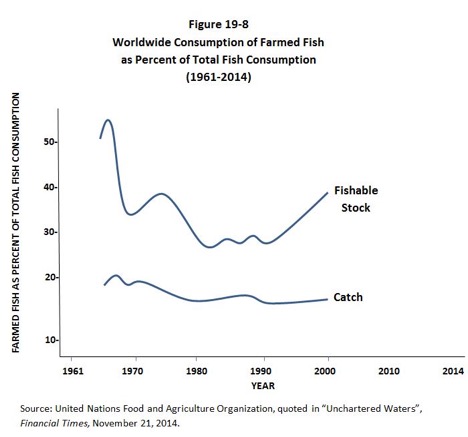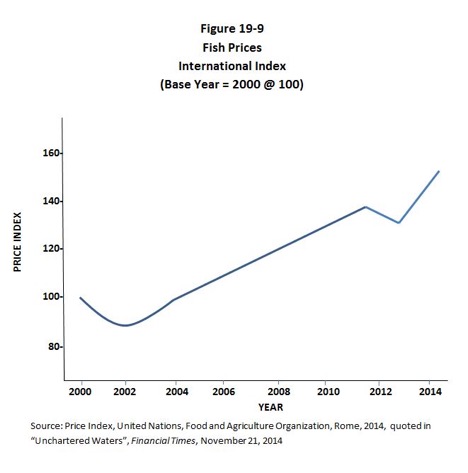| << Chapter < Page | Chapter >> Page > |
Given these pernicious influences, only about 55% of coral reefs in 2010 were considered pristine. And 25% of living reefs are gone forever. Finally, as we shall see, all coral reefs are vulnerable to global warming.

Falling levels of Omega are serious threats to the lower regions of the oceans food chain. Eventually, fisheries would be greatly affected. But at this point, we have little idea what fisheries and what species will be damaged most.
We do know that 56 million years ago (10 million years after mass extinction of dinosaurs), the oceans became very acidic due to climate change. Then, there was a 6 degree centigrade increase.
The map in Figure 19-7 indicates, among other things, that all coral reef formation could one day cease .
Consider the map again. Why do we see such low predicted Omega values near the South and North Polar Regions? Because colder polar waters dissolve atmospheric CO2 much more easily than tropic waters.This is a problem that, if it does materialize, will be quite serious for the next three generations behind the reader.
Until the mid-eighties, commercial fish farming was a relatively small industry worldwide, mostly concentrated in farms raising Pacific Salmon (in the U.S.) and Atlantic salmon (in Northern Europe, especially Norway). But in the past two decades, worldwide production of farmed fish grew at extremely rapid rates, such that the consumption of farmed fish in 2013 approximately equaled that of wild fish (see Figure 19-8). At the same time, the international index for fish prices (wild plus farmed fish) doubled from 2002 to 2014 (see Figure 19-9), making investment in fish farming quite attractive. As a result, in 2013 the industry produced $144 billion of salmon, shrimp and other seafood.


Consumption of farmed fish by 2013 was greatest for shrimp, salmon and trout, cephalopods (octopus, squid and cuttlefish) tuna, and groundfish (cod, haddock, and pollock) (see Table 19-1). Fully 56% of global shrimp consumption comes from fish farms mostly in Southeast Asia. 99% of Atlantic salmon consumed in 2013 from fish farms.
| Table 19-1
Consumption of Farmed Fish, Selected Species 2013 | |
|---|---|
| Total Value in U.S. million | |
| Shrimp | $19,400 |
| Salmon, Trout | 15,300 |
| Cephalopods | 4,000 |
| Tuna | 132 |
| Groundfish | 38 |
The shift to farmed fish has helped reduce depletion of the world natural fisheries. However, there is no guarantee that the farmed fish industry will continue to grow. This type of high-intensity farming can involve substantial water pollution (from fish feces and other sources). Moreover, high intensity farming of fish has been accompanied by the spread of diseases, such as early mortality syndrome in shrimp farming. This disease has recently killed a third of Thailand’s production, and has spread not only to nearby Malaysia, Vietnam and China, but to Mexico as well. Farmed salmon also has proven susceptible to disease, both in Chile and the U.S., and there are fears that accidental releases from fish farms will spread disease to wild salmon.

Notification Switch
Would you like to follow the 'Economic development for the 21st century' conversation and receive update notifications?